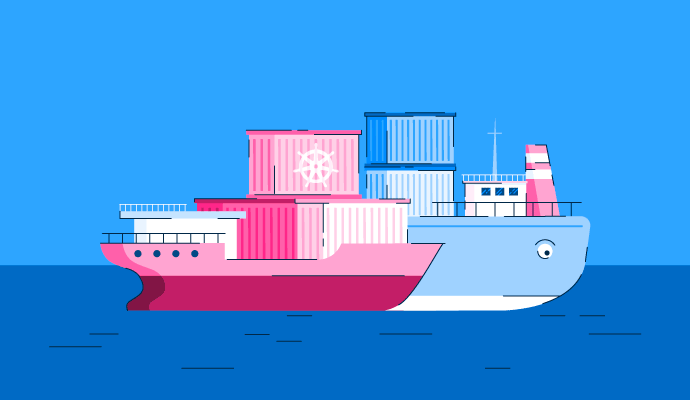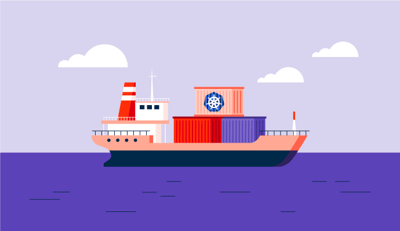August 8, 2023
 by Samudyata Bhat / August 8, 2023
by Samudyata Bhat / August 8, 2023

If you're new to the world of containers, Kubernetes and Docker are two terms you've probably heard of but may not be aware of their distinctions yet.
Should I use Kubernetes or Docker? This is a common debate between the two technologies. However, this is like saying that you have to pick between apples and apple pie.
Docker vs. Kubernetes is simpler to comprehend when presented as "both-and." You don't have to pick between Kubernetes and Docker since they are fundamentally distinct but complementary container orchestration platforms for developing, deploying, and scaling containerized programs.
Docker is a containerization platform that can run containers on a host operating system (container runtime). In contrast, Kubernetes is a framework for running and controlling containers from various container runtimes.
When Docker was introduced in 2013, it ushered in the modern era of containers and a microservices-based computing model. Containers facilitate the development of loosely coupled and scalable microservices by enabling teams’ application development, dependencies, and configuration.
As applications grew in complexity to accommodate containers distributed across multiple servers, new challenges emerged, such as coordinating metrics and scheduling multiple containers, facilitating communication between containers, and scaling container instances. Kubernetes was introduced as a solution to these difficulties. Kubernetes works with a variety of container runtimes, including Docker.
Docker is an open-source containerization technology that aids in creating, deploying, and managing containers. Docker allows developers to bundle and execute apps alongside their dependencies in containers, which are loosely segregated environments. It simplifies package application delivery by separating it from the infrastructure. Docker's technique for rapidly releasing, testing, and deploying code reduces the time between developing and operating code in production.
One of the businesses that develop the open-source Docker technology is Docker, Inc. It operates on Linux and Windows in cooperation with cloud providers like Microsoft.
Docker containers are lightweight, portable ecosystems that enable developers to bundle and run their programs with all required dependencies. Each container runs a single process, allowing several applications to be isolated and managed on a single host computer.
Docker entails the Docker Engine, a runtime environment. It enables you to build pipelines and execute containers on any development computer before storing or sharing container images via a container registry such as Docker Hub or Azure Container Registry.
There are numerous benefits to using Docker. They are discussed below.
Docker containers assist developers in creating separated and predictable environments, resulting in consistent and efficient scalability. Consequently, productivity increases since less time is spent troubleshooting and more time on introducing new consumer features.
Docker internally manages all settings and dependencies, assuring consistency from deployment to production. Scaling up allows you to add more resources when demand is high, while scaling down saves money and resources when demand is low.
Docker can cut image deployment time to seconds, which may be a significant productivity boost. An image serves as the foundation for all Docker containers. Provisioning, which includes allocating servers and resources and setting up infrastructure, has traditionally taken a long time.
Now, you can share each process with new programs by putting each process in its container. As a result, the deployment procedure is sped up.
Another advantage of utilizing Docker is its portability. If you deploy a proven containerized program to any system where Docker is operating, you can be confident that the application will function normally.
Using Docker, you may construct containers tailored to your application's demands. Docker's lightweight and portable nature enables you to scale up or down apps based on the demands and needs of your organization. You can simply manage your workload with this. There are also other container management solutions available when employing multiple containers.
Kubernetes, commonly known as K8s, is an open-source container technology that automates container applications' deployment, scaling, and administration. Users can effortlessly manage sophisticated containerized apps and services with Kubernetes, independent of their underlying infrastructure.
Kubernetes has a client-server design, with a control plane controlling the system's overall state and a collection of single nodes running the containers.
The control plane, nodes, and pods are the three fundamental components of the Kubernetes architecture. The application programming interface (API) server, etcd, scheduler, and controller manager are all control plane elements. These components collaborate to manage the lifespan of Kubernetes-based applications.
Kubernetes groups containers into logical units known as pods, which execute one or more containers concurrently. Pods assist in grouping related containers and sharing resources like networks and storage. Kubernetes also has a declarative approach for expressing the intended state of the system, allowing users to define the configuration and deployment needs of their applications in a straightforward and scalable manner.
Let's take a look at the numerous advantages of adopting Kubernetes.
Users can scale Kubernetes service applications horizontally and vertically based on resource use and user demand. Scalability and elasticity, essentially, are crucial aspects of Kubernetes clusters.
Kubernetes is highly available, reducing the risk of a single point of failure in your application. You may construct several control plane nodes using Kubernetes, which means that if one of the masters fails, the others will keep the cluster functioning.
Kubernetes offers several cloud capabilities. Its mobility allows it to handle workloads on a single cloud and applications spread across many clouds. It can also scale its environment from one cloud to another.
Since Kubernetes is adaptable, it can operate with nearly any container runtime. A container runtime software allows a container to execute on a host operating system. Furthermore, it is compatible with every underlying infrastructure, including public clouds, private clouds, and on-premises servers.
Now that we have covered the advantages and challenges of Kubernetes and Docker, let’s see how they differ from one another.
|
Features |
Kubernetes |
Docker |
|
Containerization |
Allows for the execution and management of containers |
Allows for the creation and management of containers |
|
Orchestration |
Allows for the management of container deployment and auto-scaling across host clusters |
There are no native orchestration features. It makes use of third-party technologies such as Docker Swarm. |
|
Self-healing |
Replaces failing containers with fresh ones automatically |
It lacks innate self-healing capabilities. It uses third-party technologies such as Docker Compose and Docker Swarm. |
|
Load balancing |
Offers load-balancing |
Does not contain load-balancing capabilities. It uses third-party technologies such as Docker Swarm. |
|
Storage orchestration |
Supplies a foundation for storage orchestration across host clusters. |
Not natively capable of orchestrating storage. It utilizes third-party resources, such as Flocker. |
In conclusion, Kubernetes and Docker are crucial components of the containerization ecosystem. While Kubernetes is used to manage and automate the deployment, scalability, and operation of containers across clusters of hosts, Docker is used to build and operate containers. While Kubernetes offers more sophisticated capabilities like autonomous container deployment, scalability, and self-healing, Docker provides a straightforward and effective method for running and managing containers.
Tip: Use container security tools to secure multiple components of containerized applications.
Kubernetes serves as an orchestrator for Docker containers when used with Docker. As a result, the deployment, scaling, and operation of Docker containers may be managed and automated by Kubernetes.
Docker containers may be created and managed by Kubernetes, which can also schedule their execution on the proper cluster nodes and automatically adjust the number of containers based on demand. Complex containerized applications may be created and deployed more easily because of Kubernetes' ability to control the networking and storage of Docker containers.
You may profit from both tools by combining them. While Kubernetes offers a robust infrastructure for managing and scaling containerized applications, Docker simplifies developing and bundling containerized applications. They can deliver a holistic solution for scalable containerized application management.
Additionally, virtual private cloud (VPC) solutions also assist in scaling containerized application management. They create an isolated environment where your workloads can operate on the public cloud. You can utilize the same VPC for numerous clusters, for instance, if you want to run various microservices in different clusters that need to interact with one another.
DevOps methods, containers, and Kubernetes together create a microservices architecture foundation that supports scalable orchestration and quick delivery of cloud-native applications.
Using Docker and Kubernetes together has several advantages.
There are several parallels between Kubernetes and Docker, including high availability, portability, and the capacity to disassemble programs into their component pieces. Some use cases of companies that have effectively combined Docker with Kubernetes include:
Container orchestration tools enable developers to launch several containers for application deployment. IT managers can use these platforms to automate administering instances, sourcing hosts, and connecting containers.
The following are some of the best container orchestration tools that facilitate deployment, identify failed container implementations, and manage application configurations.
* The five leading container orchestration solutions from G2’s Summer 2023 Grid® Report.

Combining DevOps techniques with Docker and Kubernetes provides a foundation for microservices architecture that encourages rapid delivery and scalable orchestration of cloud-native applications.
Kubernetes and Docker collaborate well together. Docker is an open standard for containerizing and delivering software. Docker allows you to construct and execute containers and store and distribute running container images. A Docker build can be executed on a Kubernetes cluster, but Kubernetes alone might not necessarily be an all-encompassing solution.
Both tools have advantages and disadvantages, so picking one over the other or combining them ultimately comes down to the requirements of the job at hand.
Dive deeper into the world of containers and learn about the growing relevance of containerization in cloud computing!
Samudyata Bhat is a former Content Marketing Specialist at G2. With a Master's degree in digital marketing, she specializes her content around SaaS, hybrid cloud, network management, and IT infrastructure. She aspires to connect with present-day trends through data-driven analysis and experimentation and create effective and meaningful content. In her spare time, she can be found exploring unique cafes and trying different types of coffee.
Kubernetes has experienced tremendous growth in its adoption since 2014. Inspired by Google's...
 by Samudyata Bhat
by Samudyata Bhat
The advantages of containers are numerous.
 by Maksim Blishchik
by Maksim Blishchik
The more a business relies on information technology (IT), the more important it is to have a...
 by Keerthi Rangan
by Keerthi Rangan
Kubernetes has experienced tremendous growth in its adoption since 2014. Inspired by Google's...
 by Samudyata Bhat
by Samudyata Bhat
The advantages of containers are numerous.
 by Maksim Blishchik
by Maksim Blishchik


